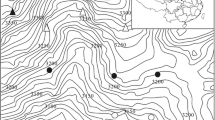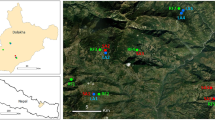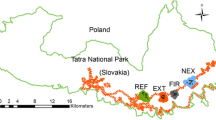Abstract
Polar willow (Salix polaris Wahlenb.), a mycorrhizal dwarf shrub, colonizes recently deglaciated areas in the High Arctic, Svalbard. To clarify successional changes in ECM fungi associated with S. polaris after glacier retreat, we examined the diversity and density of ECM fungi in culture and field conditions. Plant and soil samples were collected from three sites of different successional stages in the deglaciated area of Austre Brøggerbreen, near Ny-Ålesund, Svalbard. The successional stages were early stage with newly exposed bare ground (site I), transient stage with scattered colonization of Salix (sites IIa and IIb), and late stage with well-developed vegetation (site III). No ECM colonization on Salix was observed in soils collected from bare ground in early and transient stages (sites I and IIa). However, most Salix individuals showed ECM colonization in soils collected from sites close to Salix colonies in transient and late stages (sites IIb and III). Based on molecular analyses and operational taxonomic unit (OTU: >95% ITS sequence similarity) delimitations, we identified 15 OTUs/species in eight genera. The dominant OTU/species of ECM fungi identified in the transient and late stages was Geopora sp.1 and Cenococcum sp.1, respectively. In the culture experiment, ECM diversity was greater in late stage (eight OTUs/species) than in transient stage (three OTUs/species). This pattern was consistent with field observations, i.e., late-stage sites contained more OTUs/species of ECM fungi. These results indicate that species diversity of ECM fungi increases and the dominant species changes with the progress of succession after glacier retreat in the High Arctic.

Similar content being viewed by others
References
Allen MF (1991) The ecology of mycorrhizae. Cambridge University Press, Cambridge
Cázares E, Trappe JM, Jumpponen A (2005) Mycorrhiza-plant colonization patterns on a subalpine glacier forefront as a model system of primary succession. Mycorrhiza 15:405–416
Dickie IA, Reich PB (2005) Ectomycorrhizal fungal communities at forest edges. J Ecol 93:244–255
Fujimura KE, Smith JE, Horton TR, Weber NS, Spatafora JW (2005) Pezizalean mycorrhizas and sporocarps in ponderosa pine (Pinus ponderosa) after prescribed fires in eastern Oregon, USA. Mycorrhiza 15:79–86
Fujiyoshi M, Kagawa A, Nakatsubo T, Masuzawa T (2005) Successional changes in mycorrhizal type in the pioneer plant communities of a subalpine volcanic desert on Mt. Fuji, Japan. Polar Biosci 18:60–72
Gardes M, Bruns TD (1993) ITS primers with enhanced specificity for basidiomycetes-application to the identification of mycorrhizae and rusts. Mol Ecol 2:113–118
Graf F, Brunner I (1996) Natural and synthesized ectomycorrhizas of the alpine dwarf willow Salix herbacea. Mycorrhiza 6:227–235
Harley JL (1989) The significance of mycorrhiza. Mycol Res 92:129–139
Helm DJ, Allen EB, Trappe JM (1999) Plant growth and ectomycorrhiza formation by transplants on deglaciated land near Exit Glacier, Alaska. Mycorrhiza 8:297–304
Hesselman H (1900) Mycorrhizal formation in arctic plants (in Swedish with German summary). Bihang Till K Svensk Vetens-Akad Handlinger 26:1–46
Hrynkiewicz K, Baum C, Leinweber P (2009a) Mycorrhizal community structure, microbial biomass P and phosphatise activities under Salix polaris as influenced by nutrient availability. Eur J Soil Biol 45:168–175
Hrynkiewicz K, Baum C, Niedojadlo J, Dahm H (2009b) Promotion of mycorrhiza formation and growth of willows by the bacterial strain Sphingomonas sp. 23L on fly ash. Biol Fertil Soils 45:385–394
Ishida TA, Nara K, Ma S, Takano T, Liu S (2009) Ectomycorrhizal fungal community in alkaline-saline soil in northeastern China. Mycorrhiza 19:329–335
Jumpponen A, Trappe JM, Cazares E (2002) Occurrence of ectomycorrhizal fungi on the forefront of retreating Lyman Glacier (Washington, USA) in relation to time since deglaciation. Mycorrhiza 12:43–49
Leake J, Johnson D, Donnelly D, Muckle G, Boddy L, Read D (2004) Networks of power and influence: the role of mycorrhizal mycelium in controlling plant communities and agroecosystem functioning. Can J Bot 82:1016–1045
Lilleskov EA, Fahey TJ, Horton TR, Lovett GM (2002) Belowground ectomycorrhizal fungal community change over a nitrogen deposition gradient in Alaska. Ecology 83:104–115
LoBuglio KF (1999) Cenococcum. In: Cairney JWG, Chambers SM (eds) Ectomycorrhizal fungi: key genera in profile. Springer-Verlag, New York, pp 287–309
Mühlman O, Peintner U (2008) Mycobionts of Salix herbacea on a glacier forefront in the Austrian Alps. Mycorrhiza 18:171–180
Nakatsubo T, Fujiyoshi M, Yoshitake S, Koizumi H, Uchida M (2010) Colonization of the polar willow Salix polaris on the early stage of succession after glacier retreat in the High Arctic, Ny-Ålesund, Svalbard. Polar Res 29:385–390
Nara K (2006) Ectomycorrhizal networks and seedling establishment during early primary succession. New Phytol 169:169–178
Nara K, Hougetsu T (2004) Ectomycorrhizal fungi on established shrubs facilitate subsequent seedling establishment of successional plant species. Ecology 85:1700–1707
Newsham KK, Upson R, Read DJ (2009) Mycorrhizas and dark septate root endophytes in polar regions. Fungal Ecol 2:10–20
Obase K, Tamai Y, Yajima T, Miyamato T (2007) Mycorrhizal associations in woody plant species at the Mt. Usu volcano, Japan. Mycorrhiza 17:209–215
Peter M, Ayer F, Egli S (2001) Nitrogen addition in a Norway spruce stand altered macromycete sporocarp production and below-ground ectomycorrhizal species composition. New Phyto 149:311–325
Ryberg M, Larsson E, Molau U (2009) Ectomycorrhizal diversity on Dryas octopetala and Salix reticulate in an Alpine Cliff Ecosystem. Arct Antarct Alp Res 41:506–514
Smith SE, Read DJ (2008) Mycorrhizal symbiosis 3rd edn. Academic Press, New York
Svendsen H, Beszczynska-Møller A, Hagen JO, Lefauconnier B, Tverberg V, Gerland S, Ørbæ k Bischof K, Papucci C, Zajaczkowski M, Azzolini R, Bruland O, Wiencke C, Winther JG, Dallmann W (2002) The physical environment of Kongsfjorden-Krossfjorden, an Arctic fjord system in Svalbard. Polar Res 21:133–166
Tibbett M, Sanders FE, Minto SJ, Dowell M, Cairney JWG (1998) Utilization of organic nitrogen by ectomycorrhizal fungi (Hebeloma spp.) of arctic and temperate origin. Mycol Res 102:1525–1532
Trowbridge J, Jumpponen A (2004) Fungal colonization of shrub willow roots at the forefront of a receding glacier. Mycorrhiza 14:283–293
Väre H, Vestberg M, Eurola S (1992) Mycorrhiza and root-associated fungi in Spitsbergen. Mycorrhiza 1:93–104
White TJ, Bruns T, Lee S, Taylor J (1990) Amplification and direct sequencing of fungal ribosomal RNA genes for phylogenetics. In: Innis MA, Gelfand DH, Sninsky JJ, White TJ (eds) PCR protocols: a guide to methods and applications. Academic Press, San Diego, pp 315–322
Acknowledgments
We thank Dr. Keisuke Obase, Hokkaido University, for useful information concerning ECM identification. This study was supported by a Grant-in-Aid for Scientific Research from the Japan Society for the Promotion of Science.
Author information
Authors and Affiliations
Corresponding author
Rights and permissions
About this article
Cite this article
Fujiyoshi, M., Yoshitake, S., Watanabe, K. et al. Successional changes in ectomycorrhizal fungi associated with the polar willow Salix polaris in a deglaciated area in the High Arctic, Svalbard. Polar Biol 34, 667–673 (2011). https://doi.org/10.1007/s00300-010-0922-9
Received:
Revised:
Accepted:
Published:
Issue Date:
DOI: https://doi.org/10.1007/s00300-010-0922-9




